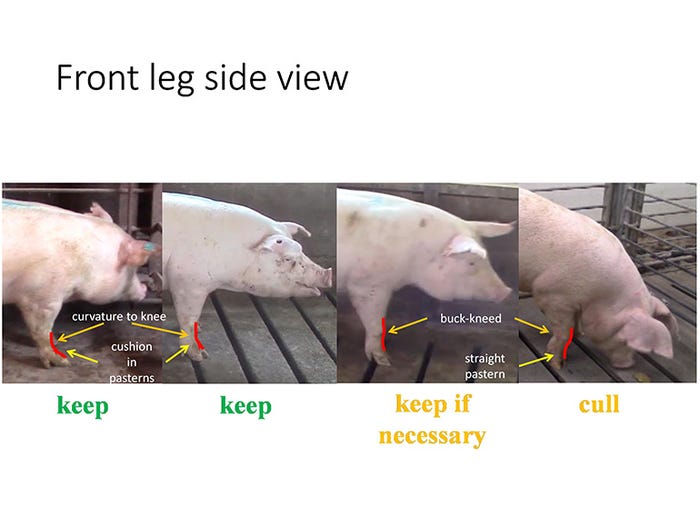Selecting replacement gilts
Eight important factors for selecting replacement gilts at the commercial level.
February 6, 2020

Selecting replacement females is an important step towards maximizing sow lifetime productivity and farm profit. Yet which traits should commercial farms focus on when selecting gilts for the sow farm? The answer perhaps depends on your goals, what traits you are able to capture, selection rate and the population from which you have to work with. Some traits may be economically important, yet better suited to be improved at the genetic nucleus versus using threshold selection at the commercial level. Below is our ranking of important factors for selecting replacement gilts.
1. Sex – While this may be obvious, often some barrows can be found at gilt multiplication units for various reasons. I'm sure some readers have stories of barrows being delivered to sow units.
2. Defects – Belly ruptures or other defects that may impede a sow's productivity.
3. Structural conformation/feet and legs – Good structural conformation is important in that it minimizes lameness issues throughout the sow's production lifetime and decreases sow culling rates. The front leg side view should resemble a "banana" with a good slope from above the knee down throughout the pastern. Gilts that are severely buck-kneed, as shown below, should always be culled. Research shows buck-kneed gilts are culled earlier than structurally correct females.

Proper slope to the rear pasterns is also important for good structural conformation. Similar to front leg side view, studies show gilts with soft rear pasterns reduce sow culling rates.

Research shows gilts that are wide through the center part of their rib cage have better sow longevity than narrow based gilts. Across the commercial pigs we have seen, rib width is generally a weakness. While replacement gilts do not need to be as wide as some pigs in the show pig industry, narrow pigs present problems. Tall, narrow sows may "flop" to stand up which is an animal well-being issue.

Identifying animals with good structural conformation can be challenging. Hence we have put together an instructional video to help farmers, and livestock judges of all ages, evaluate gilt structural conformation. Further printed tools, including selection posters and a gilt evaluation pocket guide, are available through pork.org.
4. Teat count and underline quality – Research shows each additional functional teat at farrowing improves number of piglets weaned by ~.3. Therefore the economic value of teat count is relatively great. Yet variation in teat count may be small. If a trivial proportion of gilts are below your teat count threshold (perhaps 14 teats), identifying those gilts may be challenging. Thus it is important to understand how much variation in teat count exists in your population. Teats should be counted on replacement gilts before they are weaned from their mothers. Gilts with inadequate teat count should be identified. Improvements in teat count may need to occur at the genetic nucleus level and filter down to the commercial level versus using a threshold culling level on commercial farms.
5. Age at puberty – Studies clearly show, within a cohort of gilts, younger puberty females have superior gilt and sow retention. Hence age at puberty is a good indicator of sow lifetime productivity. Puberty is a trait that can be difficult to capture, thus age at first mating is a good, similar trait. If culling based on age at first mating, one strategy may be to breed the first 80 to 90% of females that exhibit estrus (within a group) and cull the remaining late puberty gilts.
6. Weaning weight/preweaning growth rate – Research consistently shows a gilt that grows rapidly from birth to weaning will have superior sow lifetime productivity. Cross-fostering strategies, where gilts are reared in smaller litters, have been used to improve preweaning growth rate and subsequent sow lifetime productivity. Therefore we know, within a cohort of females, gilts with rapid preweaning growth have superior lifetime performance. Yet it is unclear if improving preweaning growth rate across an entire cohort (i.e. milk replacer, improved sow nutrition, etc.) would enhance subsequent reproduction.
7. Lean growth – Growth rate and backfat are largely related to feed conversion. As the mother of the commercial pig contributes 50% of the genes for lean growth to the final market pig, her genes impact the feed conversion of her progeny. While growth rate and backfat are commonly measured at the genetic nucleus, measuring these traits in gilt multiplication is currently costly. Perhaps lean growth moves up on this list in importance as technology makes it less costly to capture growth rate and backfat. Yet a better understanding of progeny feed conversion differences within a group of replacement gilts may be needed.
8. Vulva size – Traditionally vulva characteristics are thought to be criteria on which to evaluate replacement gilts. Yet limited research has not associated vulva size (~6 months of age) with subsequent reproduction. There is an adage that gilts with small vulvas are less likely to farrow a litter. Perhaps the adage stems from non-pubertal gilts having smaller vulvas than pubertal gilts and the small vulva argument is more so related to delayed puberty.
We are currently working on revamping gilt selection procedures for a production system here in North Carolina. Given the system's selection rate, we will be focusing on the first three factors listed above; sex, defects and structural conformation. We are also encouraging the system's genetic supplier to evaluate increasing the number of functional teats in their maternal lines. Questions or comments can be sent to Mark Knauer.
Sources: Mark Knauer, Dalton Obermier, Zach Peppmeier and Jeff Wiegert, who are solely responsible for the information provided, and wholly own the information. Informa Business Media and all its subsidiaries are not responsible for any of the content contained in this information asset.
You May Also Like



